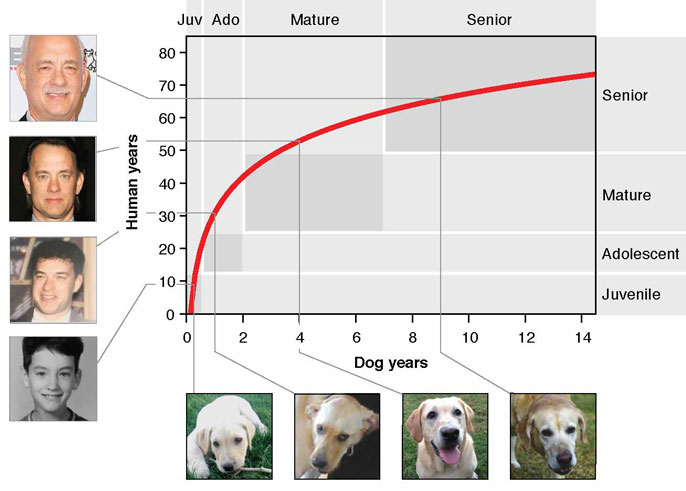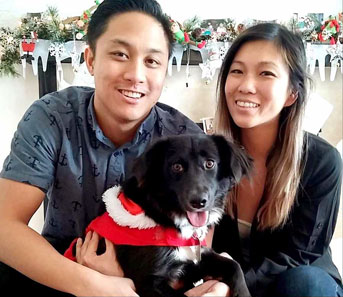If there’s one myth that has persisted through the years without much evidence, it’s this: multiply your dog’s age by seven to calculate how old they are in “human years.” In other words, the old adage says, a four-year-old dog is similar in physiological age to a 28-year-old person.
如果有一个多年来一直存在且缺乏证据的谬论,那就是:把狗的年龄乘以7,计算出它们的“人类年龄”。换句话说,4岁的狗和28岁的人生理年龄差不多。

But a new study by researchers at University of California, San Diego School of Medicine throws that idea out the window. Instead, they created a formula that more accurately compares the ages of humans and dogs. The formula is based on the changing patterns of methyl groups in dog and human genomes — how many of these chemical tags and where they’re located — as they age. Since the two species don’t age at the same rate over their lifespans, it turns out it’s not a perfectly linear comparison, as the 1:7 years rule-of-thumb would suggest.
但加州大学圣地亚哥医学院(University of California, San Diego School of Medicine)的研究人员的一项新研究推翻了这一观点。相反,他们创造了一个公式,更准确地比较了人类和狗的年龄。这个公式是基于甲基在狗和人类基因组中变化的模式。随着年龄增长,这些化学标签的数量和位置如何发生改变。由于这两个物种的衰老速度在它们的寿命中并不相同,所以这并不是一个完美的线性比较,正如1:7岁的经验法则所表明的那样。
The new methylation-based formula, published July 2 in Cell Systems, is the first that is transferrable across species. More than just a parlor trick, the researchers say it may provide a useful tool for veterinarians, and for evaluating anti-aging interventions.
7月2日发表在《细胞系统》(Cell Systems)杂志上的这个新的基于甲基的公式是第一个可以用于跨物种转移的公式。研究人员说,这不仅仅是一个非正式的小把戏,它可以为兽医提供一个有用的工具,也可以用来评估抗衰老干预措施。
“There are a lot of anti-aging products out there these days — with wildly varying degrees of scientific support,” said senior author Trey Ideker, professor at UC San Diego School of Medicine and Moores Cancer Center. “But how do you know if a product will truly extend your life without waiting 40 years or so? What if you could instead measure your age-associated methylation patterns before, during and after the intervention to see if it’s doing anything?” Ideker led the study with first author Tina Wang, who was a graduate student in Ideker’s lab at the time.
加州大学圣地亚哥医学院和摩尔癌症中心(Moores Cancer Center.)的教授、资深作者Trey Ideker说:“现在有很多抗衰老产品——它们都得到了不同程度的科学支持。但是你怎么知道一种产品是否真的能延长你的寿命而不用等到40年以后呢?如果你可以在干预之前、期间和之后测量你与年龄相关的甲基化模式,看看它是否有什么作用?”Ideker和第一作者Tina Wang一起指导了这项研究,Tina Wang当时是伊克实验室的一名研究生。
The formula provides a new “epigenetic clock,” a method for determining the age of a cell, tissue or organism based on a readout of its epigenetics — chemical modifications like methylation, which influence which genes are “off” or “on” without altering the inherited genetic sequence itself.
这个公式提供了一种新的“表观遗传时钟”,一种根据表观遗传学的读数来确定细胞、组织或有机体的年龄的方法——像甲基化这样的化学修饰,在不改变遗传序列本身的情况下影响哪些基因是“开”或“关”的。
Epigenetic changes provide scientists with clues to a genome’s age, Ideker said — much like wrinkles on a person’s face provide clues to their age.
Ideker说,表观遗传变化为科学家提供了了解基因组年龄的线索,就像人脸上的皱纹提供了了解年龄的线索一样。
Ideker and others have previously published epigenetic clocks for humans, but they are limited in that they may only be accurate for the specific individuals on whom the formulas were developed. They don’t translate to other species, perhaps not even to other people.
Ideker和其他人之前已经发表了人类的表观遗传时钟,但它们的局限性在于,它们可能只对这些公式是基于哪些特定的个体准确。它们不会传递给其他物种,甚至可能不会传递给其他人。
“We always look at humans, but humans are kind of boring,” he said. “So, she convinced me we should study dog aging in a comparative way.”
“我们总是关注人类,但人类有点无聊,”他说。“所以,她说服我,我们应该用比较的方式研究狗的衰老。”
To do that, Ideker and Wang collaborated with dog genetics experts Danika Bannasch, a professor of population health and reproduction at UC Davis School of Veterinary Medicine, and Elaine Ostrander, chief of the Cancer Genetics and Comparative Genomics Branch at the National Human Genome Research Institute, part of the National Institutes of Health. Bannasch provided blood samples from 105 Labrador retrievers. As the first to sequence the dog genome, Ostrander provided valuable input on analyzing it.
为此,Ideker和Wang与犬类遗传学专家Bannasch,加州大学戴维斯分校(UC Davis)兽医学院的人口健康和生殖教授,美国国家卫生研究院下属的美国国家人类基因组研究所,癌症遗传学和比较基因组学分会主任Elaine Ostrander进行合作。Bannasch提供了105只拉布拉多猎犬的血液样本。作为第一个对狗的基因组进行排序的人,Ostrander为分析提供了有价值的信息。
Dogs are an interesting animal to study, Ideker said. Given how closely they live with us, perhaps more than any other animal, a dog’s environmental and chemical exposures are very similar to humans, and they receive nearly the same levels of health care. It’s also important that we better understand their aging process, he said, as veterinarians frequently use the old 1:7 years ratio to determine a dog’s age and use that information to guide diagnostic and treatment decisions.
狗是一种有趣的研究动物,Ideker说。考虑到狗和我们生活得很近,可能比其他任何动物都要近,狗接触的环境和化学物质与人类非常相似,它们得到的医疗保健水平也几乎相同。他说,我们更好地了解它们的衰老过程也很重要,因为兽医经常用1比7来确定狗的年龄,并利用这一信息来指导诊断和治疗决定。
What emerged from the study is a graph that can be used to match up the age of your dog with the comparable human age (see figure). The comparison is not a 1:7 ratio over time. Especially when dogs are young, they age rapidly compared to humans. A one-year-old dog is similar to a 30-year-old human. A four-year-old dog is similar to a 52-year-old human. Then by seven years old, dog aging slows.
从这项研究中得出的结果是一个可以用来匹配狗的年龄和人类的年龄的图表(见图)。这种比较不是一段时间后1:7的比率。尤其是当狗还小的时候,它们比人类老得快。1岁的狗和30岁的人很像。4岁的狗和52岁的人很像。到7岁时,狗的衰老速度减慢。

“This makes sense when you think about it — after all, a nine-month-old dog can have puppies, so we already knew that the 1:7 ratio wasn’t an accurate measure of age,” Ideker said.
“想想看,这是有道理的——毕竟9个月大的狗也可以生小狗,所以我们已经知道1:7的比例并不是年龄的准确衡量标准,”Ideker说。
According to Ideker, one limitation of the new epigenetic clock is that it was developed using a single breed of dog, and some dog breeds are known to live longer than others. More research will be needed, but since it’s accurate for humans and mice as well as Labrador retrievers, he predicts the clock will apply to all dog breeds.
根据Ideker 的说法,新的表观遗传时钟的一个局限性是,它是用单一品种的狗开发的,而已知一些品种的狗比其他品种的狗活得更久,这还需要进行更多的研究,但由于生物钟对人类、老鼠以及拉布拉多猎犬都是准确的,他预测,这种生物钟将适用于所有犬种。
Next, the researchers plan to test other dog breeds, determine if the results hold up using saliva samples, and test mouse models to see what happens to their epigenetic markers when you try to prolong their lives with a variety of interventions.
接下来,研究人员计划测试其他犬种,确定唾液样本的结果是否成立,并测试小鼠模型,看看试图用各种干预措施延长它们的寿命时,它们的表观遗传标记会发生什么改变。
Meanwhile, Ideker, like many other dog owners, is looking at his own canine companion a little differently now.
与此同时,像许多其他狗主人一样,Ideker现在对自己的狗伴侣有了一点不同的看法。

“I have a six-year-old dog — she still runs with me, but I’m now realizing that she’s not as ‘young’ as I thought she was,” Ideker said.
“我有一只六岁的狗,它仍然和我一起跑步,但我现在意识到它已经不像我想象的那么‘年轻’了,”Ideker说。




